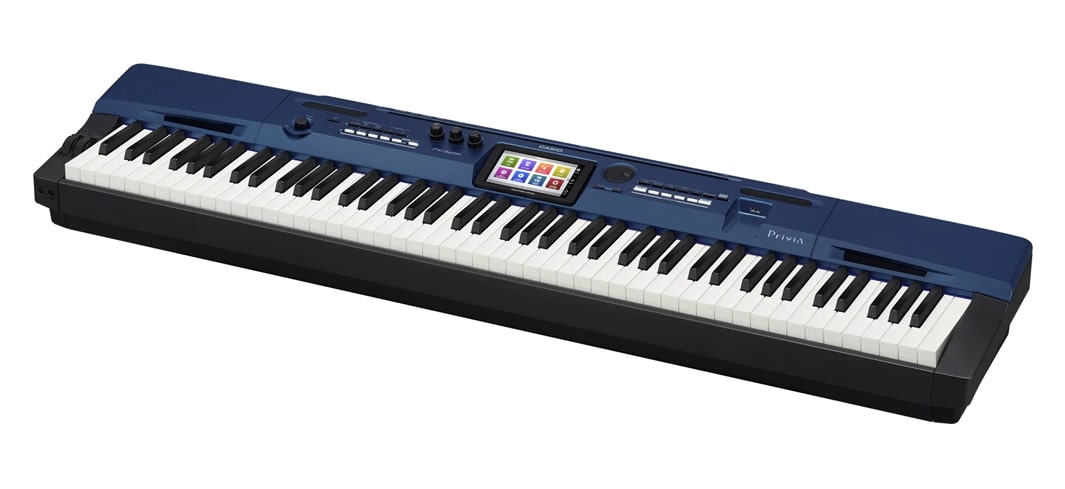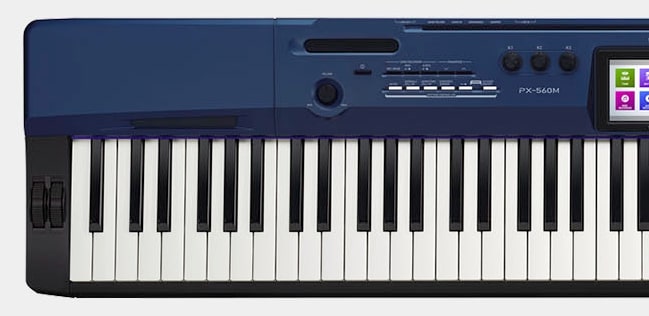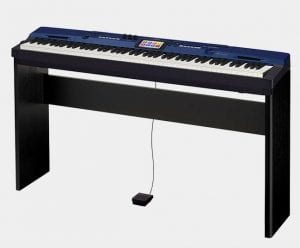The Casio PX-560 is a game-changer and adds true value to the Privia series of pianos from Casio. The Privia line has won the best dealer’s choice award for piano and the PX-560 is the best model in this line. Let us discuss the specifications and other details of this piano in detail here.
Casio Privia PX-560 Review 2024
Quick Opinion by Larry
A great easy-to-use piano with amazing sound quality at the price point. Perfect if you are a beginner or an intermediate looking for a budget piano. In short, it’s a value-for-money instrument.
Pros & Cons of Casio PX-560
What’s Best in Casio PX-560?
- The 256-note polyphony of the piano helps you to attempt any song without any hesitation.
- Compact piano with a real keyboard
- Excellent 5.3” color touchscreen
- 650 built-in sounds with ample sound customization options
- Internal memory is great to store a large number of songs
What’s Lacking in Casio PX-560?
- Flimsy sustain pedal
- No options to connect with real-time apps or Bluetooth
- Its keys can get a little noisier compared with other pianos.
Check out: Best Digital Pianos in the Market
The External Features of the PX-560
Size and Weight
The Casio PX-560 is a compact and portable line of Pianos from Casio. This versatile piano measures 51.9 x 11.5 x 5.7 inches and is a little heavy at 26.5 kg compared with the S1000 and S3000 models. But still, you can carry it around in a keyboard bag for all your performances.
The Looks of the Piano
The PX 560 looks simple and elegant. It looks pretty much beautiful in its bright design. Its external body features a rare combination of blue and matte black plastic, rendering it a fresh and interesting look. Its build quality is excellent and is a decent tradeoff for pianos in the lightweight option. The piano is available in only one finish.

The Keys
The PX-560 comprises 88 fully weighted keys. The keys are made up of plastic with ebony and ivory simulations. The keys follow a graded hammer action pattern from left to right with the keys on the right feeling lighter than those on the left. As the keys of the piano feature a textured surface, they absorb moisture pretty well and are great for those playing in hot and humid weather.

The Controls
The control panel is a huge plus for the PX 560 and it has been made intuitive and pretty simple to navigate. One important specification that pertains to its controls, which is definitely not found in other pianos is the color touchscreen that is capable of displaying a number of text lines at one time. This feature makes it the best piano in the Privia line, as its predecessors just display three lines of text. Also, the screen is placed at the center of the piano with several functions surrounding it.
The screen is also huge, about 5.3 inches. It helps people to carry out all programmable activities at ease and it serves as one of the most programmable digital pianos available at present. Apart from the screen, there are also 7 physical controls for volume, dial knob, pitch bend wheel, modulation wheel, etc. Pianists can also be sure that they can easily access all the main functions and settings on the piano during a studio session or a live performance.
The Music Rest
The PX 560 features a centrally placed music rest which is wide enough to keep the music sheets and read comfortably at a convenient angle. Though the music rest is not wide enough as we get in PX-S1000 and S3000, it can still accommodate a number of music sheets for display at a single time.
The Internal Features and Functions of the Keyboard
How Do the Keys Work?
The PX-560 makes use of a Tri-sensor scaled hammer action with its keys and they also have ivory and ebony texturing on them. All of its 88 fully weighed keys make use of little hammers to reproduce the feel of the real piano action. It makes use of triple sensor technology as well and each of the keys has three sensors to detect keystrokes and to facilitate playing unique nuances with note repetition easily.
As we know, all digital pianos follow the graded hammer action and the keys at the right end feel lighter than the keys at the left. The PX560 follows the same pattern and its keys are touch-sensitive. Each of the keys responds differently, depending on the force exerted on them, and the harder you play, the louder is the instrument sound. There are a few settings to help you adjust the degree of sensitivity from light, and normal to heavy and as an option, you can choose to turn off the touch sensitivity feature to help the keyboard sound the same, no matter how hard you hit the keys.
Check out: Best Digital Pianos Under $1000
How the Piano Sounds – Sound Effects and Speakers
Like the other pianos from Casio, the PX560 also features multi-dimensional AiR sound source technology. This piano, in particular, makes use of multi-layered samples, meaning that every single note of this instrument was recorded many times at different volume levels so as to replicate the dynamic range of a grand piano.
The memory capacity of this piano has also been enhanced multiple times, thus helping the pianist to make use of longer and high-quality sound samples. And it has about 650 built-in sounds with ample scope for multiple sound designs, open to the skills and imaginative power of the pianist.
Over 20 piano tones have been built into this instrument, and its acoustic simulator feature helps the pianist to play realistic tones by adjusting the resonance and hammer response according to their preferences. About 600 tunes of electric pianos, organs, guitars, synths, and string ensembles are also built into this instrument which sounds realistic, helping for a one-man band as you would expect from your instrument.
Check out: Best Sounding Digital Pianos: Top 10 Most Realistic Pianos
Customization Options with Sounds
There are several unique customization options available with the piano and trust me, you can create the best masterpieces with the inbuilt tunes and sounds of this PX 560.
- There are 17 reverb options, 16 chorus types, and 6 delay types.
- There are 20 digital signal processing effects in this piano, which include an enhancer, rotary, compressor, phaser, etc.
- You can increase or decrease frequencies of sounds within particular frequency bands with the help of its Master EQ option.
- There are a modulation wheel and the pitch bend wheel at the left corner of the piano to help you apply the effects on the tunes of the piano in real-time.
- The Low-frequency oscillator feature helps you to edit defined parameters in the piano, such as the amp, delay depth etc.
There are also a number of other customization options available with this piano, which you may have to try and for yourself. But its touchscreen helps you to keep on track of all your modifications, taking sound customization to an all-new level.
The Speakers
Its speakers are very powerful and help pianists with awesome sound systems onboard. It has four speakers in total and this is why we call the PX 560 an excellent workstation piano. The total output from its four speakers is 16 W. They could go as loud as 91.5 decibels at a 3-foot distance, which is similar to an acoustic piano. The quality of sound that comes out of these pianos are also impressive and you can always pair the piano with good external speakers or headphone to experience the best quality sound.
Sound Recording and Playback
The piano can play in four modes, namely the duet play mode, layer mode, split mode, and the Hex Layer feature that allows the pianist to layer up to six different tones on top of each other. The PX 560 also comes with a number of auto-accompaniment functions so that you can create up to 200 styles to cover a vast range of music genres.
When it comes to song recording, there are indeed two types of data that you can cover with the PX 560. You can record up to 100 songs with 16 tracks each with its onboard MIDI recorder and save them in its internal memory. You can also make use of its built-in audio recorder feature to record the actual sound of your performance in WAV format.
The best part of this piano is that, when you end up recording your file, you can get them played on your MP3, smartphones, and other devices pretty easily. The arpeggiator is a special feature of this PX560 that takes notes as you play and repeats them in a specific pattern to create an arpeggio. You also have the metronome to adjust the beat, volume, and tempo of the songs.
Connectivity Features
- There are two stereo mini jacks to plug the headphones on the left side of the piano.
- There is a USB Type-A port on the front to plug in the flash drive
- The USB port B helps to connect the piano with a mobile device, or a computer to exchange MIDI data and files.
- The MIDI In and Out terminal helps with data exchange between the PX560 and other MIDI devices.
- There is also an assignable pedal jack to connect with an expression pedal.
Check out: Casio CGP-700 Review
Alternatives of Casio PX-560
Here are a few top alternatives for Casio PX-560 that come under $1500 budget.
Final Verdict
The Casio PX560 is definitely the best bet for its cost and it packs a number of useful features for an entry-level piano. It is a versatile instrument that is capable of handling a number of music situations starting from solo playing to creating own music and participating in live performances.

